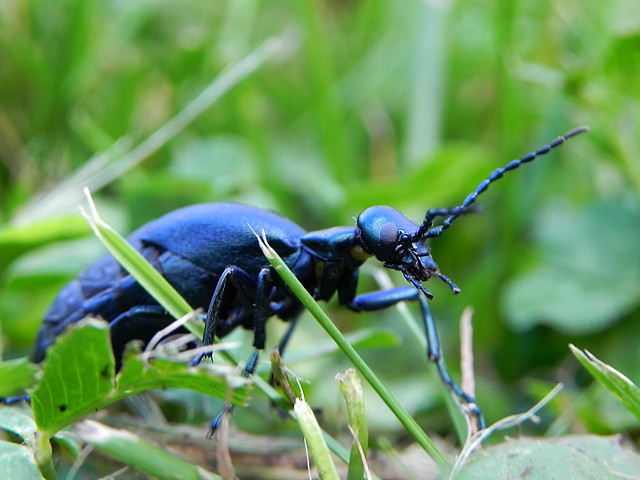My children and their friends spotted some strange insects at Audubon the other day. They were dark steely blue, shining in the grass. Their bulbous round abdomens looked awkward compared to their skinny heads and thoraxes. These beetles crawled in an ungainly fashion through the grass, looking almost zombie-like as they lurched along.

These odd little insects are known as Oil Beetles and are part of a family of beetles known as Blister Beetles. Blister Beetles have ways to protect themselves using a basic form of chemical warfare. According to Arthur Evans, author of the book Beetles of North America, in an interview with Vermont Public Media, “Their name, Oil Beetle, comes from the fact that as a defense measure they secrete cantharidin from their leg joints. You’ll see these oily yellow drops on their knees, and it’s very caustic. It causes blisters. They belong to a much larger group of beetles referred to as Blister Beetles.”
We have picked up these beetles in the past with no ill effects. This time, however, my daughter noticed an oily droplet on the beetle’s head as she was holding it and quickly dropped it back onto the ground.
Cantharidin, the chemical that is secreted by the American Oil Beetle, is incredibly toxic. On the skin, it can cause blisters and burns if not washed off. If eaten, it can be fatal. That said, one related species of Blister Beetle in Europe was known as “Spanish Fly”. These beetles were dried, crushed and used as an aphrodisiac.
“Cantharidin is about as toxic as cyanide and strychnine and there’s no known antidote,” according to the podcast Chemistry World. “Notorious French aristocrat, the Marquis de Sade, got in trouble for giving prostitutes a box of chocolates laced with Spanish Fly. The women survived but de Sade was sentenced to death for attempted murder.”
Cantharidin, like many toxic chemicals, may have important medical use that goes far beyond the somewhat creepy uses of Spanish Fly. “One other interesting little tidbit about cantharidin is that apparently it has anti-cancer properties. It’s been applied to tumors and found to reduce them in size, so there’s more study that needs to be done on Oil Beetles and their cousins” according to Evans.
I wrestled with deep personal doubts when I decided to write about these beetles. Knowledge can be a dangerous thing. I worry that someone who once ignored these beetles and never had any intention of touching one might now see one and kill it on sight. Please don’t. They are a fascinating animal that will not harm you if you leave them alone.
Nature is a treasure trove of fascination. There are always new things to learn and discover and Oil Beetles are full of amazing things. The mother can lay up to 10,000 eggs. Young Oil Beetles have a special name when they hatch: triungulins. They are not yet maggot-like larvae. Instead, they resemble tiny, two-tailed insects that “behave like shrews on amphetamines, and run up and down plants, seemingly without any purpose”, according to Harvard Entomologist Piotr Naskrecki.
Whatever you think they are trying to accomplish by running up and down plants, forget it. That is not the reason. According to Nasrecki, these tiny triungulins gather together at the top of a plant and begin emitting pheromones, a kind of super attractive insect perfume, that attracts male solitary bees.
When the male bee approaches, hoping for a mate, the triungulins hop aboard and hold on. If and when the male finds a real female bee, “they pass the larvae onto her like some six-legged venereal disease”, according to Nasrecki. The triungulin then ride on the back of the female solitary bee to her underground tunnel. They hop off and start devouring the bee’s eggs and the pollen that the bee stored for her young.

This is another point in this story where I thought “Will bee and pollinator lovers go off and start killing American Oil Beetles?” Please remember that this is a natural cycle that has happened since long before you were born and will continue long after you are dust. The bees’ overall population will continue. Please do not harm them.
The story gets boring from here, as the young beetles go through their life cycles, called hypermetamorphosis (because of the extra triungulin stage), eat pollen, make underground pupae and emerge as the odd, deep metallic blue beetle that we found trudging zombie-style through the grass.
That is not the end of the story, however. Just like people have found uses for these beetles, so have animals. White-breasted Nuthatches sweep their nest holes with Oil Beetles to irritate potential predators. Research also shows that some frogs and birds are immune to the toxin in the beetles and eat them to eliminate parasites, according to the National Institutes of Health.
Nature always surprises. These fairly common beetles would not normally get a second look, yet they are full of surprises. Oil Beetles showcase a totally weird life cycle, toxins that can cause both pain and pleasure, and the potential to be part of the cure for cancer. They are worth keeping around.
Audubon Community Nature Center builds and nurtures connections between people and nature. ACNC is located just east of Route 62 between Warren and Jamestown. The trails are open from dawn to dusk as is Liberty, the Bald Eagle. The Nature Center is open from 10 a.m. until 4:30 p.m. daily except Sunday when it opens at 1 p.m. More information can be found online at auduboncnc.org or by calling (716) 569-2345.


Recent Comments